Crane lifts Jeju Air’s plane wreckage as South Korea searches for bodies
South Korean families who lost loved ones in a disastrous plane crash which killed almost everyone onboard have watched on as the grim task of recovering the bodies ramps up. See the pics.
World
Don't miss out on the headlines from World. Followed categories will be added to My News.
South Korean investigators said Friday they expected to find more human remains as they began lifting the wreckage of the Jeju Air jet that crashed on landing last weekend killing all but two of the 181 passengers and crew aboard.
Using large yellow cranes, investigators began lifting sections of the plane’s scorched fuselage Friday, including what appeared to be an engine and the tail section.

“Today, we will lift the tail section of the plane,” said Na Won-ho, head of investigations for the South Jeolla provincial police.
“We expect there may be remains found in that section,” he told a press conference at Muan International Airport, where the crash happened.
“For all that to be complete and to have the results, we must wait until tomorrow.”
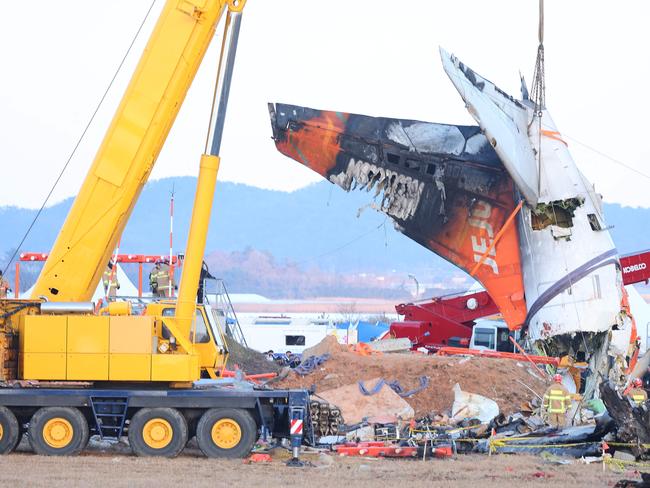
Because of the violent destruction of the aircraft, officials said some of the bodies suffered extreme damage, and it was taking investigators time to piece them together while also preserving crash site evidence.
All 179 victims have been identified, however, and some bodies have been released to families for funerals to begin.
Police have vowed to quickly determine the cause and responsibility for the disaster, but the transport ministry said it could take six months to three years.
AIRPORT OFFICES RAIDED
South Korean police raided the offices of Jeju Air and the operator of Muan International Airport as they stepped up a probe into the fatal crash of a Boeing 737-800 that killed 179 people.
Authorities on Thursday local time carried out search and seizure operations at Muan airport where flight 2216 crashed, a regional aviation office in the southwestern city, and Jeju Air’s office in the capital Seoul, police said.
Photographs show airport security attempting to lock out investigators who nevertheless left with boxes of evidence.
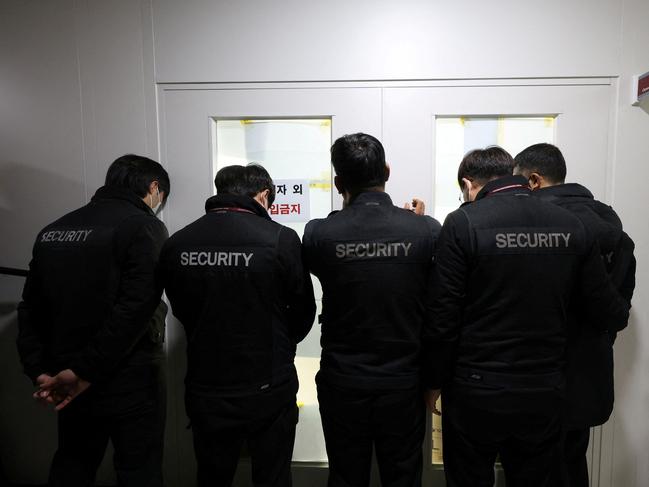
Jeju Air’s chief executive Kim E-bae has also been banned from leaving the country as the investigation continues, police said separately.
“The police plan to swiftly and rigorously determine the cause and responsibility for this accident in accordance with the law and principles,” police said in a statement sent to AFP.
At Muan airport Thursday, soldiers, police and white-suited investigators were still combing the crash site, as orange-robed monks held prayer ceremonies nearby.
Officials initially pointed to a bird strike as a possible cause of the crash, and have since said the probe was also examining the role of a concrete barrier at the end of the runway.
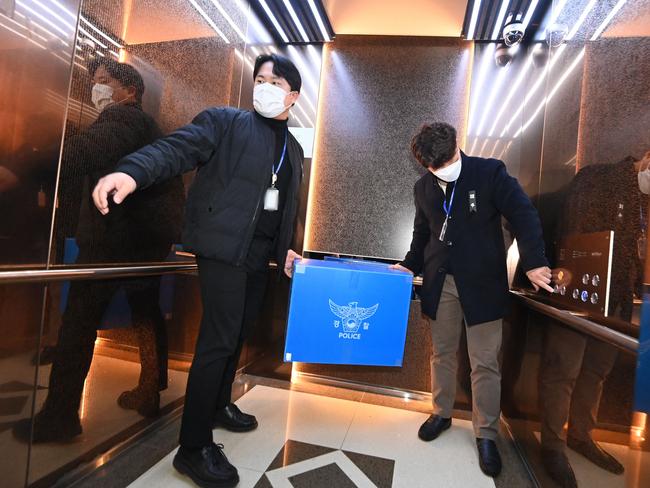
Yonhap reported the Muan airport warrant was approved on charges of professional negligence resulting in death, citing officials.
“Police are securing evidence related to the legitimacy of the airport’s localiser,” Yonhap said, referring to the concrete wall at the end of the runway housing an antenna array.
They are also seeking communication records between the control tower and the pilot shortly before the plane crash, it added.
Airports nationwide were being inspected to check other similar localisers, the land ministry said in a statement.
Some experts have suggested that the disaster may have been less deadly if the installation not been concrete.
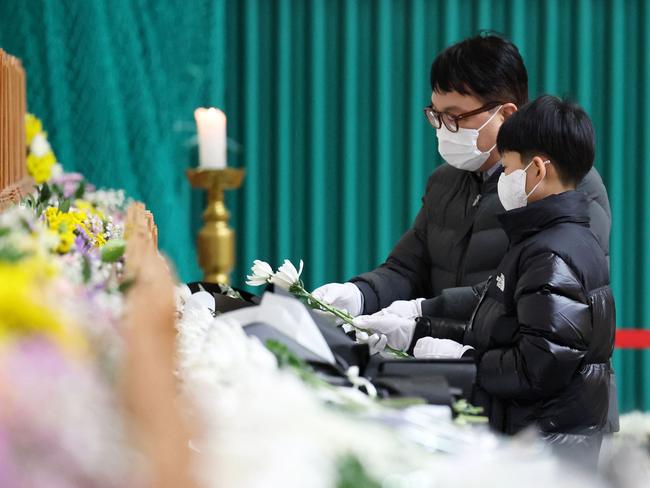
MOURNERS LINE TARMAC
Authorities have released 11 bodies from the Jeju Air plane crash to grieving relatives who have descended in their hundreds upon Muan International Airport, in southern South Korea.
The Jeju Air crash which killed 179 people is the worst aviation disaster on South Korean soil in decades.
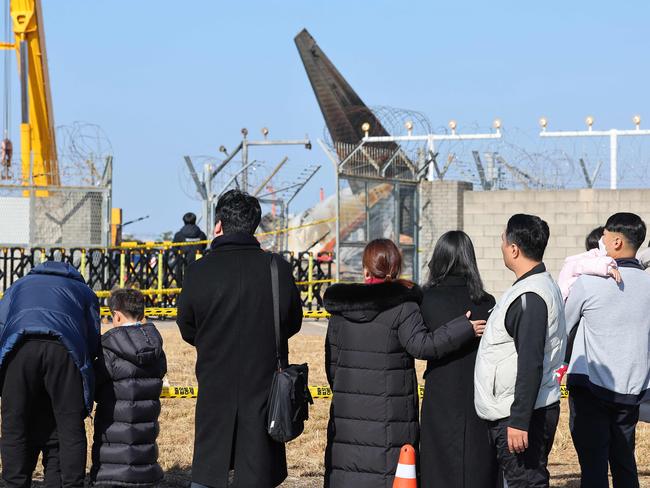
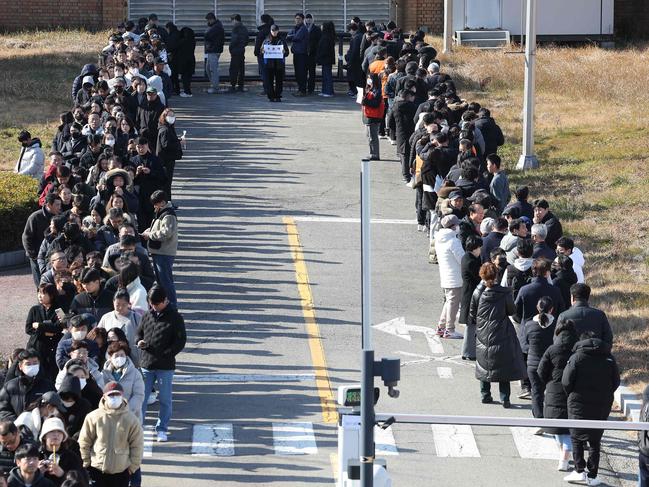
As South Korea observes seven days of mourning, relatives lined the tarmac on New Year’s Day to catch a glimpse of the final resting place of their loved ones.
The first day of the year is considered an auspicious time in South Korea, and so the stricken families laid a memorial table with food including “ddeokguk” – a traditional rice cake soup eaten January 1.
Many mourners wept while others laid white floral tributes and bowed to honour their fallen.
BLACK BOX DATA RETRIEVED
Investigators probing the crash have extracted the initial data from one of the Boeing 737-800’s black boxes, an official said Wednesday.
The plane was carrying 181 people from Thailand to South Korea when it issued a mayday call and bellylanded before hitting a barrier and bursting into flames, killing everyone aboard except two flight attendants pulled from the burning wreckage.
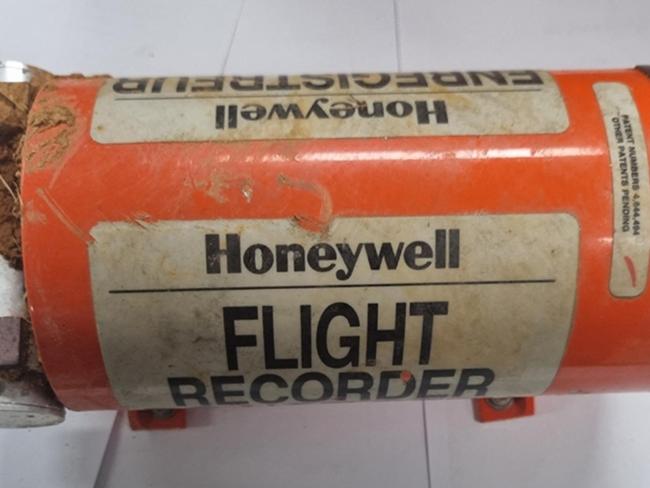
South Korean and US investigators, including from Boeing, have been combing over the crash site in southwestern Muan since the disaster Sunday.
Both of the plane’s black boxes were retrieved, and for the cockpit voice recorder, “the initial extraction has already been completed,” said deputy minister for civil aviation Joo Jong-wan.
“Based on this preliminary data, we plan to start converting it into audio format,” he said, meaning investigators would be able to hear the pilots’ final communications.
The second black box, the flight data recorder, “was found with a missing connector,” Joo said. “Experts are currently conducting a final review to determine how to extract data from it.”
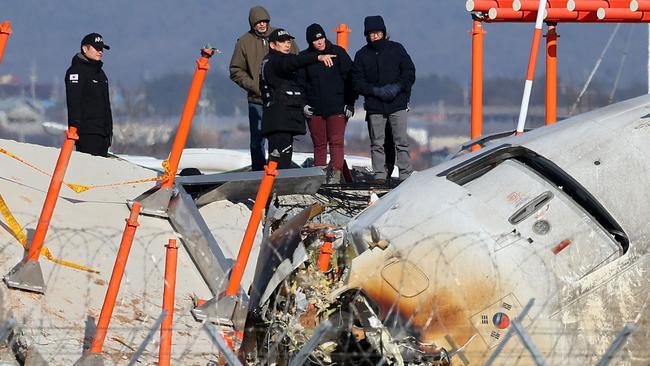
Officials initially pointed to a bird strike as a possible cause of the disaster, but the initial on-site joint probe has focused on a navigation system that assists in aircraft landings, known as a localiser. Installed on a concrete structure, it is the barrier at the end of the runway that has been blamed for exacerbating the severity of the crash.
There have also been questions over possible mechanical failures, with local media reporting that the landing gear had deployed properly on Jeju Air Flight 2216’s first failed landing attempt at Muan airport before failing on the second.
The issue “will likely be examined by the Accident Investigation Board through a comprehensive review of various testimonies and evidence during the investigation process,” the ministry of land, which oversees civil aviation, said at a briefing.
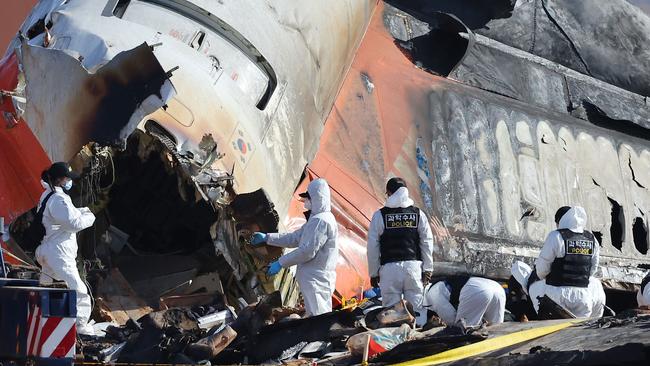
At Muan airport, grieving families of victims had become increasingly frustrated by delays in identifying and releasing the bodies.
Officials have said the bodies were extensively damaged by the crash, making the work of identifying remains slow and immensely difficult, even as investigators had to preserve crash-site evidence.
But the country’s acting president, Choi Sang-mok, said Wednesday the process had finally been completed, and that more bodies had been handed over to relatives so that they could hold funerals.
DARK PAST OF DOOMED CRASH JET REVEALED
The doomed Jeju Air plane that crashed in South Korea had previously been damaged in a runway smash despite initial claims the jet had no history of accidents.
Flight 2216 crash-landed at Muan International Airport before skidding off the runway and crashing into a concrete wall, killing 179 people on board.
Two flight attendants, who had been sitting at the back of the plane, miraculously survived and were pulled from the wreckage.
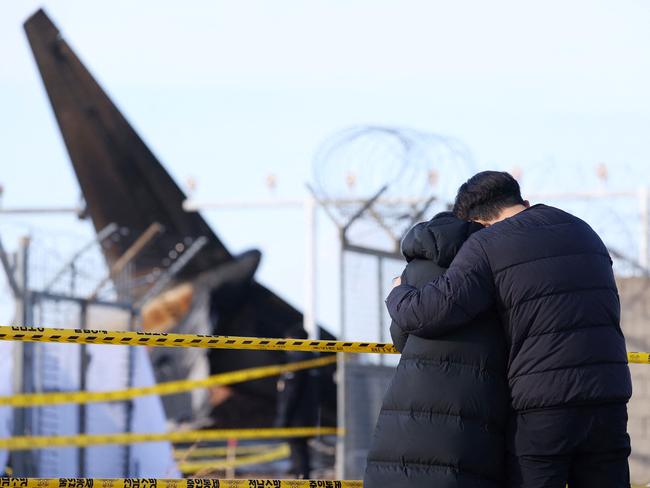
A damning report, published by JTBC news, has revealed that in 2021 the tail of the Boeing 737-800’s fuselage came into contact with the runway.
The plane was damaged, but Jeju allegedly continued to fly as planned, leading to a hefty fine.
Jeju Air said in a statement that the 2021 collision was a “non-accident” under aviation law as the damage to the plane was not significant, defending its earlier claim that the plane had no accident history.
It came as flight records cited by Yonhap news agency showed the Jeju Air flight flew 13 times in just 48 hours.
The plane travelled between Muan, Jeju Island and Incheon, as well as Beijing, Bangkok, Kota Kinabalu, Nagasaki and Taipei before the crash.
SOUTH KOREA ORDERS STRICT BOEING PROBE
US air safety officials and staff from the beleaguered aircraft maker Boeing were arriving to join investigators probing the worst air disaster on South Korean soil, which officials initially blamed on a collision with birds.
The plane was carrying 181 people from Thailand to South Korea when it made a mayday call and belly landing before crashing into a barrier and bursting into flames.
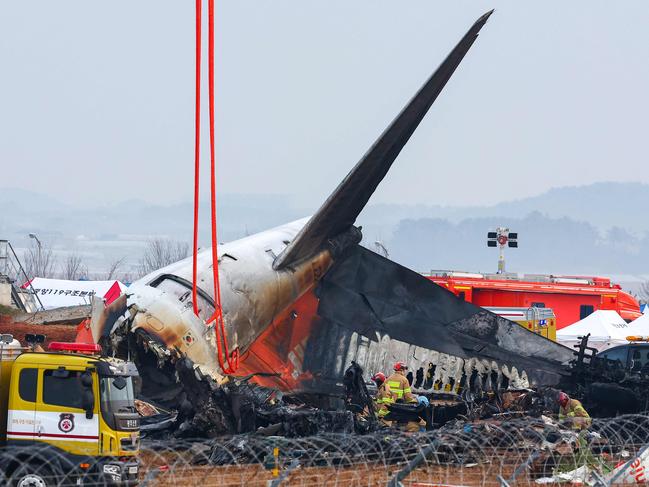
Another Jeju Air flight using the same model aircraft experienced a malfunction linked to the landing gear and was forced to return to Seoul’s Gimpo International Airport shortly after take off on Monday, the airline said.
The company’s share price dropped as much as 15 per cent on Monday, with anxious customers also cancelling some 68,000 flights with the airline, Jeju Air told AFP.
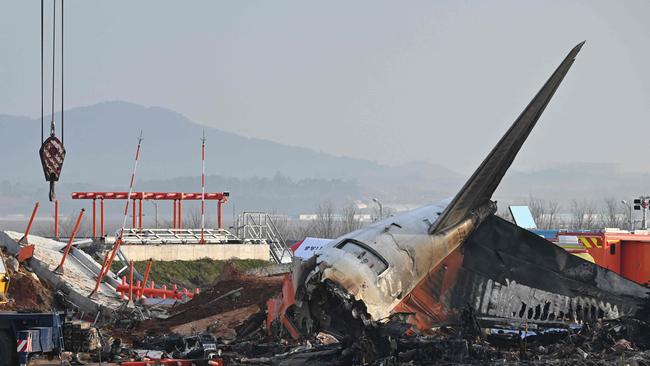
South Korea began seven days of mourning, with flags flying at half-mast and the acting president flying to the crash site in southwestern Muan for a memorial.
Acting President Choi Sang-mok, who has only been in office since Friday, said the government was making “every effort” to identify victims and support bereaved families.
Choi, an unelected bureaucrat who became acting president after his two predecessors were impeached, said a “thorough investigation into the cause of the accident” would be conducted.
He also said South Korea would conduct “an urgent safety inspection of the overall aircraft operation system” to prevent future aviation disasters.
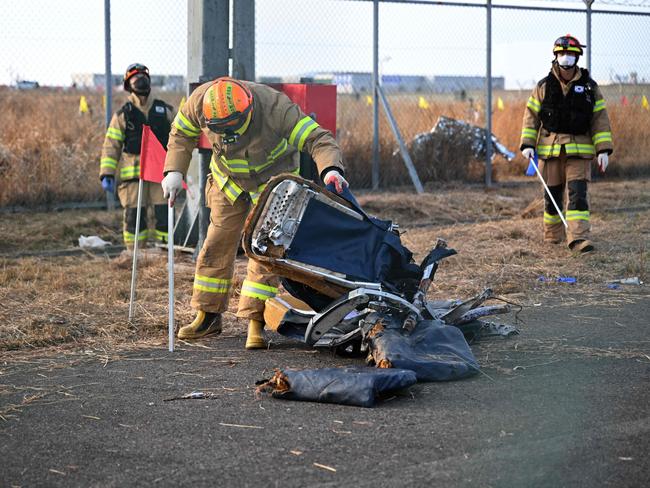
South Korea has a solid air safety record and both black boxes from Flight 2216 — the flight data recorder and the cockpit voice recorder — have been found.
Officials have so far identified 146 victims using DNA analysis or fingerprint collection, said deputy minister for civil aviation, Joo Jong-wan.
“As for the comprehensive inspection, maintenance records of key systems such as engines and landing gear will be thoroughly reviewed for 101 aircraft operated by six airlines using the same model as the accident aircraft,” he said.
“This process will be carried out intensively starting today and continuing until January 3, 2025.”
Victims’ families camped out at the airport overnight in special tents set up in the airport lounge after a long, painful day waiting for news of their loved ones.
“I had a son on board that plane,” said an elderly man waiting in the airport lounge, who asked not to be named, saying that his son’s body had not yet been identified.
At the crash site, a middle-aged man and woman kept their gaze fixed through the fence, where remnants of the plane — seats, gates, and twisted metal parts — were still scattered across the field near the charred tail.
Soldiers carefully combed through a field of reeds next to the runway, engaged in what appeared to be a search for body parts.
The passengers, aged from three to 78, were all Korean apart from two Thais, authorities said.
Low-cost carrier Jeju Air said it “sincerely” apologised, with top officials shown bowing deeply at a news conference in Seoul.
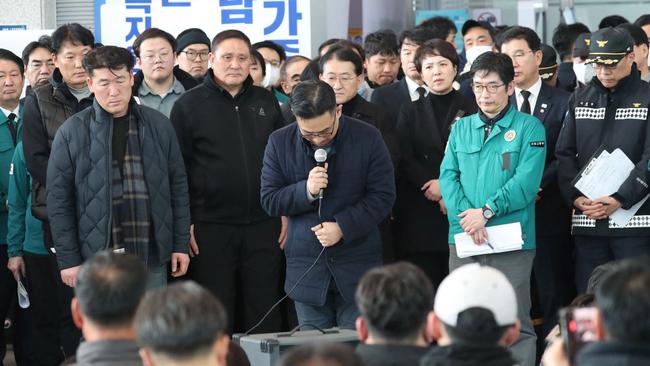
King Charles and Queen Camilla paid tribute to the 179 people killed saying they were “profoundly saddened to learn of the horrific air accident at Muan” and the families and loved ones of the victims were in their prayers.
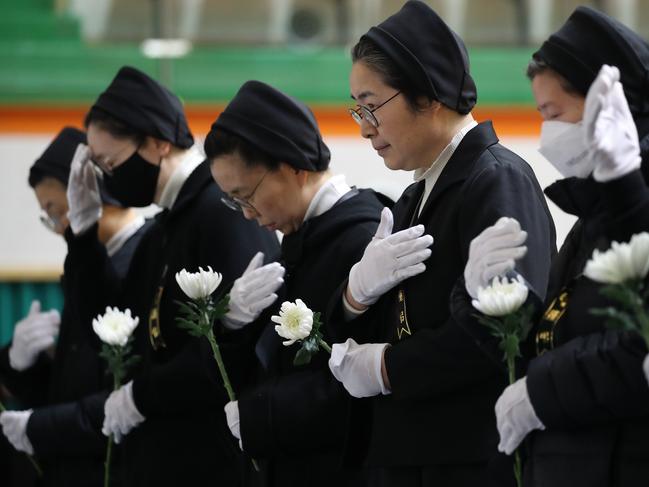
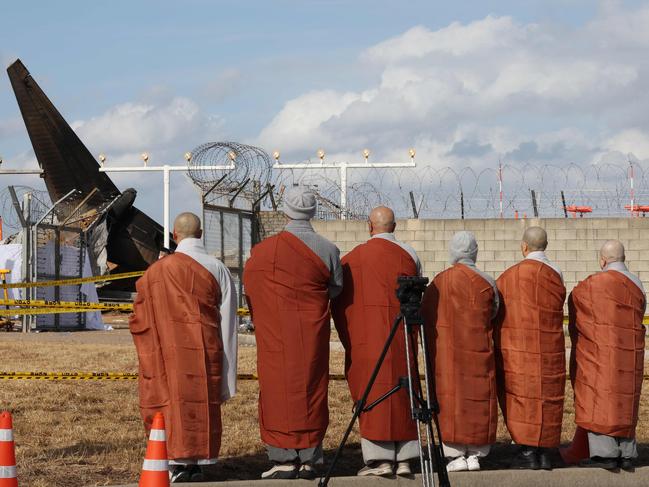
A growing chorus of criticism from experts analysing dramatic video footage of Flight 2216’s landing has focused on whether airport construction could have played a part.
Kim Kwang-il, professor of Aeronautical Science at Silla University and a former pilot, said he was “quite upset” when he reviewed video showing the plane making a skilled emergency landing but then hitting a wall.
“There shouldn’t have been a solid structure in that area at all,” he told AFP. “Normally, at the end of a runway, there’s no such solid obstruction — it’s against international aviation safety standards,” he said.
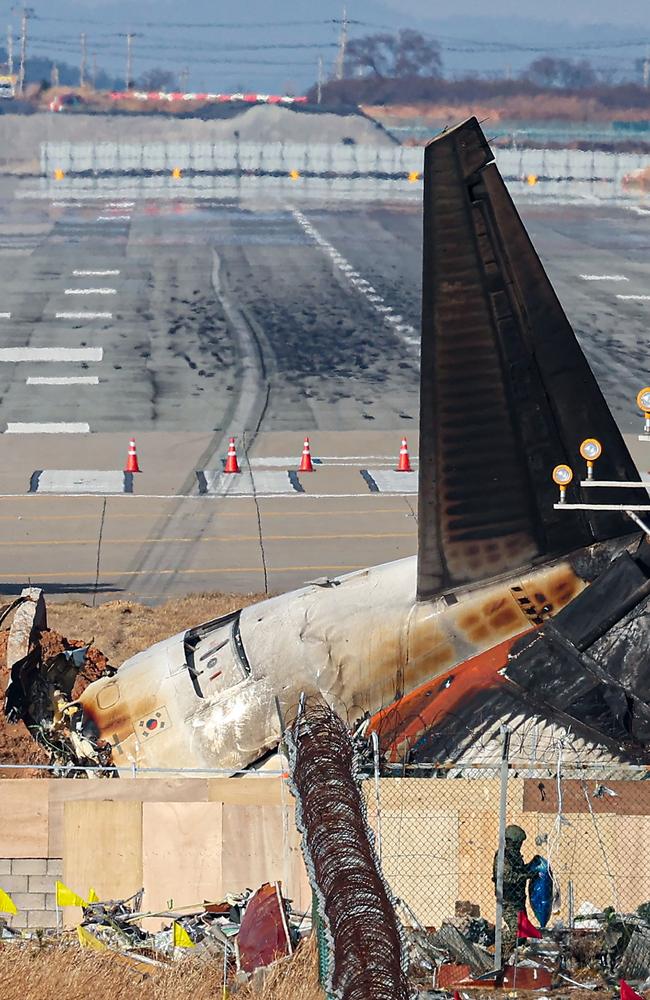
“The structure in question caused the aircraft to crash and catch fire.”
“Outside the airport, there are usually just fences, which are soft and wouldn’t cause significant damage. The plane could have skidded further and stopped naturally. The unnecessary structure is highly regrettable.”
– With AFP
Originally published as Crane lifts Jeju Air’s plane wreckage as South Korea searches for bodies




